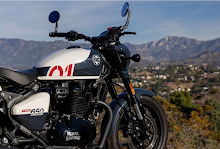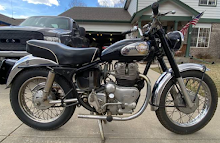Many thanks to reader Ken Bleeker for coining the phrase "accidental survival component."
He wrote me, drawing attention to a Motofire.com article about the challenges motorcycles face in some markets (including here in North America).
The article notes the downturn in motorcycle sales, and suggests that ever bigger, ever faster, ever more expensive new motorcycles may be limiting access and interest among young people and women — thus shrinking the pool of potential customers
Ken thinks that Royal Enfield motorcycles — perhaps because with few exceptions they have not been speedy — successfully appeal to a wider range of riders, including women and such non-traditional groups as adventurers on 'round-the-world trips.
He notes that CEO Siddhartha Lal's focus on mid-size and less expensive motorcycles has spared Royal Enfield the bigger/faster/lighter/costlier craze other marks have suffered.
A resident of South Africa, Ken rides a 1999 Royal Enfield Lightning 500 and has owned BSAs. He describes how he brought a Royal Enfield Bullet 500 back to life for his son.
"It came in many banana boxes — besides the frame and wheels, the crankshaft and Albion four-speed gearbox having to be retrieved from the seller's brother.
"Anyhow there was so much potential that with about six months' admin — the previously registered owner having died, with no known administrator of his estate and only living relative a daughter in the USA — we managed to get the bike road registered."
The dooms-day article he pointed to concerned the formation of a group calling itself Give A Shift (GAS). GAS brought 25 motorcyclists, seven of them women, together Nov. 16 just before the International Motorcycle Show in Long Beach, Calif. to discuss saving the motorcycle.
GAS called itself a "public discourse on the future of motorcycling" meant to "develop ideas and spur new ones that will help stem the losses and malaise surrounding the contemporary motorcycling market and culture."
 |
| Sales of new motorcycles are in a terrible slump in the U.S.; but notice that we've been here before, from 1989 to 1996. |
I'm only interested in vintage motorcycles and the few new motorcycles — mostly Royal Enfields — that pay tribute to vintage style and character. Why should I even care about sales of newer looking, ever faster motorcycles?
Perhaps because, without a strong motorcycle industry to advocate for it, the motorcycle as a vehicle could get whacked as an element in the transportation mix of the future. Few of my fellow citizens would mourn the passing of a dangerous and loud vehicle that doesn't play nice in traffic.
Look, as the rider of a 1999 Royal Enfield Bullet, I already experience elimination from relevance.
Highway speeds exclude me. Even on city streets any modern car can out-brake me, making me a cautious commuter. There are many days I take my car instead of the Bullet because I can't spare the added travel time the Bullet requires or risk the cut-and-thrust of rush hour traffic outside my armored steel box.
Will "many days" become "all days" soon? Yes, absolutely, as I eventually age out of motorcycling altogether.
Here's the good news: modern, faster Royal Enfields — especially the coming 650 twins — solve all these problems (except my age!), without losing their vintage appeal.
In India Royal Enfield doesn't need saving at all. With sales up month after month, new factories, improved products, new product lines, and high-status consumer awareness, it is a raging success.
On the other hand, in North America, on top of the fact that it is little known here, Royal Enfield faces the same "malaise" the better known brands confront.
Perhaps Ken's Accidental Survival Component will help overcome that. The Guido Ebert study that underlies the GAS discussion gives some support for that possibility.
New motorcycle sales in the U.S. are indeed in a slump, but just such a slump occurred 30 years ago, the report observes. That earlier slump hit a low in 1992, but sales rebounded starting in 1993.
What that earlier slump and this one share are economic factors. Both slumps occurred during severe downturns in the U.S. economy.
No surprise: when consumers are hurting they stop buying new motorcycles. But the motorcycle industry can't count on today's improving economy alone to spur sales.
That's because the Baby Boomers (like me) are old enough that we won't be buying many more motorcycles. We bought our bikes when the economy improved after the slump of the 1990s. If sales are to recover from the Great Recession of this century, the maturing people of Generation X and the young men and women of the Millennials will have to do the buying.
If these folks can be encouraged to get into motorcycling, as GAS fervently hopes, Royal Enfield's notably quite affordable, mid-size products should be well positioned to serve them.






















I have been riding for more than 50 years. When I started there were no license endorsements needed. Motorcycles were cheap and plentiful. Montgomery Wards; Sears; Western Auto along with many mom and pop operations sold bikes. A year or so later came the legislation requiring special motorcycle endorsements. The amount of bikes sold went down precipitously. In the mid-1970s Joan Claybrook and her minions destroyed the 2-stroke market. Add to that nearly 35 years of tripe written about how dangerous motorcycles are have chased away many. Motorcycle shows seem to be the "Land of Old Men." I hope this organization can turn it around. I have enjoyed motorcycling for a very long time. I would like to see others enjoy it as well.
ReplyDeleteI actually feel resentment they din't just take the Continental GT and didn't just put in it a new twin based on the unit construction engine with same long stroke and didn't just dress the bike to look like the original Interceptor, same specs...!!! The C5 is basically made like this.
ReplyDeleteThe new Interceptor is not a classic bike anymore. It is more like the Triumph Thruxton. I think, the new twins are good marketing, but a step in the wrong direction and a sad view on the future of this brand from the purist point of view.
Unfortunately too. Motorcycles are not compatible with self driving cars. And sdc's are the future.
ReplyDeleteDon